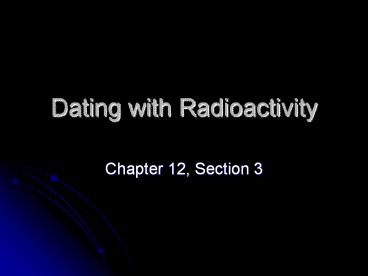Dating with Radioactivity - PowerPoint PPT Presentation
Title:
Dating with Radioactivity
Description:
Dating with Radioactivity Chapter 12, Section 3 Basic Atomic Structure Each atom has a nucleus containing protons and neutrons and that nucleus is orbited by ... – PowerPoint PPT presentation
Number of Views:1272
Avg rating:3.0/5.0
Title: Dating with Radioactivity
1
Dating with Radioactivity
- Chapter 12, Section 3
2
Basic Atomic Structure
- Each atom has a nucleus containing protons and
neutrons and that nucleus is orbited by electrons - Electrons have a negative electrical charge and
protons have a positive charge - Neutrons have no charge
- The atomic number of an element is the number of
protons in the nucleus, atoms of the same element
always have the same atomic number - An atoms mass number is the number of protons
and neutrons in a nucleus - The number of neutrons can vary in a nucleus, and
these variants, or isotopes, have different mass
numbers
3
Radioactivity
- The forces that bind protons and neutrons
together in a nucleus are usually strong - When nuclei are unstable, they spontaneously
break apart, or decay, in a process called
radioactivity - Radioactivity the spontaneous decay of certain
unstable atomic nuclei - An unstable radioactive isotope of an element is
called the parent - The isotopes that result form the decay of the
parent are called the daughter products - Radioactive decay continues until a stable or
non-radioactive isotope is formed
4
Common Types of Radioactive Decay
5
Half-Life
- Half-Life the time for one half of the atoms of
a radioactive substance to decay to its stable
isotope - If the half-life of a radioactive isotope is
known and the parent/daughter ratio can be
measured, the age of the sample can be calculated
6
Radioactive Decay Curve
7
Concept Check
- What is a half-life?
- The amount of time necessary for one half of the
nuclei in a sample to decay to its stable isotope.
8
Radiometric Dating
- Radiometric Dating the procedure of calculating
the absolute ages of rocks and minerals that
contain radioactive isotopes - Each radioactive isotope has been decaying at a
constant rate since the formation of the rocks in
which it occurs - The products of decay have also been accumulating
at a constant rate - As uranium decays, atoms of the daughter product
are formed, and measurable amounts of lead
eventually accumulate - An accurate radiometric date can be obtained only
if the mineral remained in a closed system during
the period since its formation - Although the basic principle of radiometric
dating is simple, the actual procedure is quite
complex
9
Radioactive Isotopes Frequently Used in Radiometric Dating Radioactive Isotopes Frequently Used in Radiometric Dating Radioactive Isotopes Frequently Used in Radiometric Dating
Radioactive Parent Stable Daughter Product Currently Accepted Half-Life Values
Uranium-238 Lead-206 4.5 Billion Years
Uranium-235 Lead-207 713 Million Years
Uranium-232 Lead-208 14.1 Billion Years
Rubidium-87 Strontium-87 47.0 Billion Years
Potassium-40 Argon-40 1.3 Billion Years
10
Concept Check
- Why is a closed system necessary in radiometric
dating? - An accurate radiometric date can be obtained only
if the mineral remained in a closed system since
its formation.
11
Dating with Carbon-14
- Radiocarbon (Carbon-14) Dating method for
determining age by comparing the amount of
carbon-14 to the amount of carbon-12 - Carbon-14 is continuously produced in the upper
atmosphere - It becomes incorporated with carbon dioxide,
which is absorbed by living matter - All organismsincluding youcontain a small
amount of carbon-14 when an organism dies, the
amount of carbon-14 gradually decays - By comparing the ratio of carbon-14 to carbon-12
in a sample, radiocarbon dates can be determined - Because the half-life of carbon-14 is only 5730
years, it can be used to date recent geologic
events up to about 75,000 years ago - Carbon-14 is a valuable tool to anthropologists,
archeologists, and historians
12
Production and Decay of Carbon-14
13
Concept Check
- What is compared when dating with carbon-14?
- The ration of carbon-14 to carbon-12.
14
Importance of Radiometric Dating
- Radiometric dating has produced dates for
thousands of geologic events in Earths history - Rocks formed on Earth have been dated to be as
much as 4 billion years old - Meteorites have been dated at 4.6 billion years
old - Radiometric dating has supported the ideas of
James Hutton, Charles Darwin, and many others who
inferred the geologic time must be immense
15
Assignment
- Read Chapter 12, Section 3 (pg. 347-350)
- Do Section 12.3 Assessment 1-6 (pg. 350)































